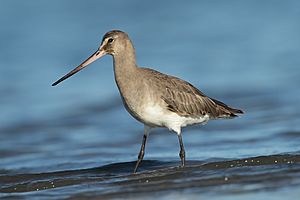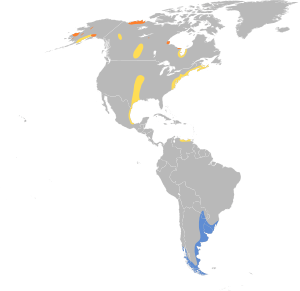Hudsonian godwit facts for kids
Quick facts for kids Hudsonian godwit |
|
|---|---|
 |
|
| Conservation status | |
| Scientific classification | |
 |
|
| Synonyms | |
|
The Hudsonian godwit (Limosa haemastica) is a large shorebird. It belongs to the sandpiper family, Scolopacidae. Its scientific name, Limosa haemastica, has interesting roots.
The word Limosa comes from Latin and means "muddy." This makes sense because these birds often live in muddy areas. The word haemastica comes from Ancient Greek and means "bloody." This might refer to the bird's reddish color. In the 1700s, people sometimes called this bird the "red-breasted godwit." The name "godwit" itself was first used around 1416. People think it sounds like the bird's call.
Contents
What They Look Like
Adult Hudsonian godwits have long, dark legs. Their bill is pink and long, curving slightly upwards. The tip of the bill is dark.
Their upper body is mottled brown, which means it has patches of different shades of brown. Their belly and chest are a pretty chestnut color. The tail is black, and the rump (the area above the tail) is white. When they fly, you can see their black wing linings. Their legs and feet are a bluish-grey color.
| How Big Are They? | |
|---|---|
| Length | 14.5–16.7 in (370–420 mm) |
| Weight | 300 g (11 oz) |
| Wingspan | 29 in (740 mm) |
| Wing | 195.5–208.5 mm (7.70–8.21 in) |
| Tail | 70–83.8 mm (2.76–3.30 in) |
| Culmen (bill length) | 68.2–81.2 mm (2.69–3.20 in) |
| Tarsus (lower leg) | 53.5–59.5 mm (2.11–2.34 in) |
Life Cycle: Breeding
Hudsonian godwits breed in the far northern parts of the world. Their breeding grounds are near the tree line in northwestern Canada and Alaska. They also breed on the shores of Hudson Bay.
They build their nests on the ground. These nests are usually hidden very well in marshy areas. The female godwit typically lays four eggs. These eggs are olive-buff in color and have darker spots. The eggs hatch after about 22 days. Both parent birds take care of the young. The baby birds can find their own food. They are also able to fly within a month after hatching.
Amazing Journeys: Migration
These birds are known for their long migrations. They travel all the way to South America and the Caribbean for the winter. Before their journey south in the fall, many birds gather at James Bay.
If the weather is good, many Hudsonian godwits fly south without stopping. This is a very long flight! Sometimes, these birds can wander off course. They have been seen as far away as Europe, Australia, and South Africa. You can often spot them during migration on the east coast of North America. They are quite common there in late July and early August.
What They Eat
Hudsonian godwits find their food by probing in shallow water. They use their long bills to search for food in the mud. Their diet mainly consists of insects. They also eat crustaceans, which are small creatures like crabs or shrimp.
Protecting These Birds
At the end of the 1800s, the number of Hudsonian godwits dropped a lot. This was mainly because of hunting. Today, efforts are made to protect these amazing birds and their habitats.
See also
 In Spanish: Aguja café para niños
In Spanish: Aguja café para niños


